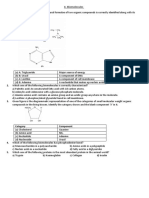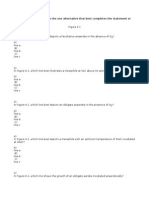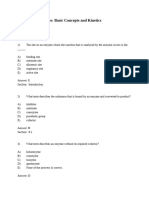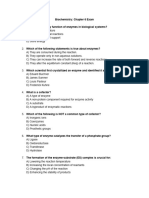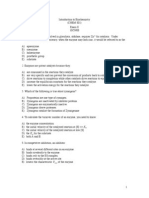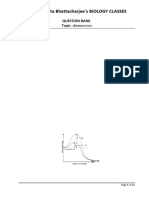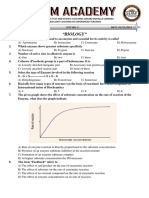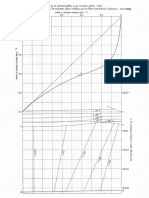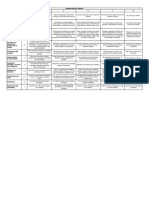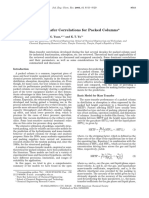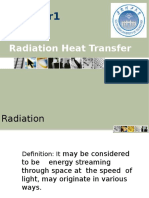Stoker C21
Stoker C21
Uploaded by
Aldren RebaLdeCopyright:
Available Formats
Stoker C21
Stoker C21
Uploaded by
Aldren RebaLdeOriginal Description:
Copyright
Available Formats
Share this document
Did you find this document useful?
Is this content inappropriate?
Copyright:
Available Formats
Stoker C21
Stoker C21
Uploaded by
Aldren RebaLdeCopyright:
Available Formats
Chem 121 Sample Question Chapter 21: Enzymes and Vitamins 1.
What is the function of enzymes within living systems? A) structural elements B) neurotransmitters C) catalysts D) hormones 2. Enzymes have names that A) always end in -ase B) always end in -in C) can end either in -in or -ase D) can end in either -in or -ogen 3. In which of the following is the pairing between enzyme type and enzyme function incorrect? A) nucleases - hydrolysis of sugar-phosphate ester bonds in nucleic acids B) synthetase - formation of new bond between two substrates C) kinase - transfer of amino groups between substrates D) carboxylase - removal of carbon dioxide from substrate 4. Which of the following is always present in both conjugated enzymes and simple enzymes? A) protein B) a vitamin C) a cofactor D) a coenzyme 5. The protein portion of a conjugated enzyme is called a(n) A) apoenzyme. B) coenzyme. C) holoenzyme. D) cofactor. 6. An enzyme active site is the location in the enzyme where A) protein side groups are brought together by bending and folding to form a site for interactions with substrates B) the catalyst interactions with the enzyme C) catalyst molecules are generated D) the substrate creates the catalyst molecules 7. Which of the following enzyme properties is explained by the lock-and-key model for enzyme action? A) high turnover rate B) absolute specificity C) susceptibility to denaturation D) susceptibility to deactivation
Page 1
8. An enzyme that catalyzes the reactions of L-amino acids but not D-amino acids would be described as showing A) linkage specificity B) absolute specificity C) group specificity D) stereochemical specificity 9. A plot of enzyme activity (y-axis) vs. pH (x-axis) with other variables constant is a A) straight line with an upward slope. B) line with an upward slope and a long flat top. C) line with an upward slope followed by a downward slope. D) straight horizontal line. 10. A plot of enzyme activity (y-axis) versus substrate concentration (x-axis) with other variables constant is a A) straight line with an upward slope. B) line with an upward slope and a long flat top. C) line with an upward slope followed by a downward slope. D) straight horizontal line.
11. Which of the following statements concerning a competitive enzyme inhibitor is correct? A) it competes with substrate for occupancy of the enzyme's active site B) binds at the active site simultaneously with the substrate C) it breaks the enzyme down to its constituent amino acids D) its effect can be overcome by increasing the temperatuer
12. Which of the following binds to an enzyme at a location other than the active site? A) substrate B) irreversible inhibitor C) reversible competitive inhibitor D) reversible noncompetitive inhibitor
13. The number of substrate molecules acted upon per minute by one molecule of enzyme is called the A) active site number. B) enzyme activity number. C) turnover number. D) optimum number.
Page 2
14. The final product of a series of enzyme-catalyzed reactions causes the enzyme that catalyzes the first reaction of the series to be inhibited. This is an example of A) positive regulator control. B) substrate control. C) feedback control. D) competitive control.
15. Which of the following substance is a zymogen? A) angiotensin B) pepsin C) proelastase D) subtilisin 16. The number of known vitamins is A) 10. B) 13. C) 15. D) 20. 17. In which of the following pairs of vitamins are both members of the pair water-soluble? A) vitamin D and pantothenic acid B) vitamin D and vitamin K C) vitamin K and vitamin B3 D) thiamin and biotin 18. Vitamins A and D are important, respectively, in A) vision and proper use of calcium and phosphorus B) vision and bone formation C) antioxidant activity and blood clotting D) proper use of calcium and phosphorus and blood clotting 19. The major function for B vitamins within the human body is as A) antioxidants. B) components of coenzymes. C) regulators of cell differentiation. D) regulators of calcium ion and phosphate ion concentrations in blood. 20. All of the B vitamins, except one, contain heterocyclic nitrogen ring systems as part of their structure. The exception is A) riboflavin. B) thiamin. C) pantothenic acid. D) biotin.
Page 3
21. Which of the following would be the name for an enzyme? A) succinate dehydrogenase B) pyruvate C) pepsin D) more than one correct response E) no correct response 22. Which of the following pairings of terms is correct? A) A kinase is a transferase. B) A mutase is a ligase. C) A synthase is a lyase. D) more than one correct response E) no correct response 23. Which of the following could be a component of a conjugated enzyme? A) coenzyme B) cofactor C) apoenzyme D) more than one correct response E) no correct response 24. In which of the following pairs of terms do the two terms have the same meaning? A) holoenzyme and conjugated enzyme B) coenzyme and simple enzyme C) apoenzyme and cofactor D) more than one correct response E) no correct response 25. An enzyme active site is the location in an enzyme where substrate molecules A) are generated. B) become catalysts. C) undergo change. D) more than one correct response E) no correct response 26. Which of the following statements concerning enzyme active sites is incorrect? A) They generally involve only a small portion of the enzyme. B) Noncompetitive inhibitors can change active site shape. C) The lock-and-key model of enzyme activity assumes that an active site has a fixed, rigid geometrical conformation. D) more than one correct response E) no correct response
Page 4
27. In which of the following pairs of enzymes is the first listed enzyme more limited in its scope than the second listed enzyme? A) linkage-specific enzyme, absolute-specific enzyme B) stereochemical-specific enzyme, linkage-specific enzyme C) group-specific enzyme, stereochemical-specific enzyme D) more than one correct response E) no correct response 28. Which of the following statements concerning the effect of temperature change on an enzyme-catalyzed reaction is incorrect? A) An increase in temperature can stop the reaction by denaturing the enzyme. B) An increase in temperature can increase the reaction rate by increasing the speed at which molecules move. C) An increase in temperature to the optimum temperature maximizes reaction rate. D) more than one correct response E) no correct response 29. Which of the following statements about a competitive inhibitor is correct? A) It must resemble the substrate in general shape. B) Its effect can be diminished by increasing substrate concentration. C) It and the normal substrate simultaneously occupy the active site. D) more than one correct response E) no correct response 30. Which of the following binds to an enzyme at its active site? A) irreversible inhibitor B) reversible competitive inhibitor C) reversible noncompetitive inhibitor D) more than one correct response E) no correct response 31. In which of the following pairs of substances are both members of the pair zymogens? A) pepsin and pepsinogen B) proelastase and elastase C) prothrombin and pepsinogen D) more than one correct response E) no correct response 32. Which of the following is not a water-soluble vitamin? A) vitamin C B) vitamin A C) vitamin D D) more than one correct response E) no correct response
Page 5
33. Which of the following pairings of vitamins and functions is correct? A) vitamin E; an antioxidant B) vitamin C; a coenzyme C) vitamin D; maintenance of mucous membranes D) more than one correct response E) no correct response 34. Which of the following B vitamins has a structure in which a metal atom is present? A) folate B) biotin C) vitamin B12 D) more than one correct response E) no correct response 35. Which of the following statements concerning sources for B vitamins is correct? A) Most fruits are poor sources. B) Most vegetables are good sources. C) Meat and dairy products are good sources. D) more than one correct response E) no correct response
Page 6
Use the following to answer questions 36-45: In each of the following multiple-choice questions, characterize EACH of the three given statements as being TRUE or FALSE and then indicate the collective true-false status of the statements using the choices a) All three statements are true. b) Two of the three statements are true. c) Only one of the statements is true. d) None of the statements is true. 36. Statements: (1) The active site of an enzyme always contains one or more metal atoms. (2) The water-soluble vitamins are the B vitamins and vitamins A and C. (3) An enzyme's turnover number is the rate at which it is degraded and resynthesized within the human body. A) All three statements are true. B) Two of the three statements are true. C) Only one of the statements is true. D) None of the statements is true. Statements: 37. (1) An apoenzyme, by itself, has no biochemical activity. (2) Urease is an example of an enzyme with absolute specificity. (3) All enzymes have names which end in -ase. A) All three statements are true. B) Two of the three statements are true. C) Only one of the statements is true. D) None of the statements is true.
38. Statements: (1) The primary function of vitamin D in the body is that of an antioxidant. (2) Holoenzymes are conjugated enzymes. (3) An increase in enzyme activity is always associated with an increase in the temperature of an enzyme-containing system. A) All three statements are true. B) Two of the three statements are true. C) Only one of the statements is true. D) None of the statements is true.
Page 7
39. Statements: (1) Activation of a zymogen produces a proteolytic enzyme. (2) An enzyme-substrate complex is the final product in most enzyme-catalyzed reactions. (3) Three forms are vitamin A are active in the human body. A) All three statements are true. B) Two of the three statements are true. C) Only one of the statements is true. D) None of the statements is true. 40. Statements: (1) A substrate is the substance upon which an enzyme acts. (2) Competitive enzyme inhibition is a reversible process. (3) Vitamin C is necessary for the formation of the structural protein collagen. A) All three statements are true. B) Two of the three statements are true. C) Only one of the statements is true. D) None of the statements is true. 41. Statements: (1) The enzyme lactase catalyzes the hydrolysis of lactose. (2) The spent form of vitamin E is regenerated by vitamin C. (3) All coenzymes are cofactors but not all cofactors are coenzymes. A) All three statements are true. B) Two of the three statements are true. C) Only one of the statements is true. D) None of the statements is true. 42. Statements: (1) Enzymes undergo all of the reactions of proteins including denaturation. (2) Vitamin E, a cholesterol derivative, can be synthesized in the skin by sunlight irradiation. (3) The optimum pH for enzyme activity within the human body is always within the physiological pH range of 7.0 to 7.5. A) All three statements are true. B) Two of the three statements are true. C) Only one of the statements is true. D) None of the statements is true.
Page 8
43. Statements: (1) All of the B vitamins are water-soluble. (2) The induced-fit model for enzyme action allows for small changes in active-site geometry. (3) Noncompetitive enzyme inhibitors bind to an enzyme at sites other than the active site. A) All three statements are true. B) Two of the three statements are true. C) Only one of the statements is true. D) None of the statements is true. 44. Statements: (1) The B vitamins serve as components of coenzymes. (2) Associated with allosteric enzyme action are substances known as regulators. (3) Kinases belong to the class of enzymes called isomerases. A) All three statements are true. B) Two of the three statements are true. C) Only one of the statements is true. D) None of the statements is true. 45. Statements: (1) The process of enzymatic browning requires the presence of oxygen. (2) The mode of action of penicillin drugs is selective competitive reversible inhibition. (3) Isoenzymes, enzymes which exist in several forms, are used to confirm the diagnosis of a heart attack. A) all three statements are true B) two of the three statements are true C) only one of the statements is true D) none of the statements is true Use the following to answer questions 46-50: For each of the enzyme actions, choose the general enzyme type from the response list. Responses may be used more than once or need not be used at all. a) lyase b) isomerase c) transferase d) oxidoreductase 46. Removal of CO2 from a substrate 47. Transfer of a phosphate group between substances 48. Conversion of a D isomer to the L isomer
Page 9
49. Introduction of a double bond by removal of hydrogen from a substrate 50. Transfer of an amino group between substrates Use the following to answer questions 51-55: For each of the descriptions of enzyme action, choose from the response list the type of inhibitor or regulator that is involved. Responses may be used more than once or need not be used at all. a) reversible competitive inhibitor b) reversible noncompetitive inhibitor c) irreversible inhibitor d) positive regulator 51. Forms one or more covalent bonds at an enzyme active site 52. Decreases enzyme activity by binding at a site other than the active site 53. Must resemble a substrate closely in shape and charge distribution 54. Mode of action of nerve gases 55. Mode of action of penicillins Use the following to answer questions 56-60: Match each of the enzyme descriptions with an appropriate characterization from the response list. Responses may be used more than once or need not be used at all. a) component of all conjugated enzymes b) component of some conjugated enzymes c) has both protein and nonprotein parts d) inactive precursor of an enzyme 56. Apoenzyme 57. Coenzyme 58. Holoenzyme 59. Zymogen 60. Cofactor
Page 10
Use the following to answer questions 61-65: Descriptions of the variables needed to plot a graph on which enzyme activity is the y-axis. For each description choose from the response list the shape of the resulting graph. Choices may be used more than once or need not be used at all. a) line with an upward slope b) line with a downward slope c) line with an upward slope and a long flat top d) line with an upward slope followed by a downward slope 61. Increase in pH with all other variables constant 62. Increase in temperature up to the optimum temperature with all other variables constant 63. Increase in temperature beginning at the optimum temperature with all other variables constant 64. Increase in substrate concentration with all other variables constant 65. Increase in enzyme concentration with all other variables constant Use the following to answer questions 66-70: For each of the descriptions of a vitamin, select from the response list the name of the vitamin. Responses may be used more than once or need not be used at all. a) vitamin D b) vitamin C c) vitamin K d) vitamin B12 66. Cosubstrate in the formation of the structural protein collagen 67. Structure contains a cobalt atom 68. Important in the blood-clotting process 69. Structural derivative of cholesterol 70. Water-soluble vitamin that is not a B vitamin
Page 11
Answer Key Chapter 21
1. 2. 3. 4. 5. 6. 7. 8. 9. 10. 11. 12. 13. 14. 15. 16. 17. 18. 19. 20. 21. 22. 23. 24. 25. 26. 27. 28. 29. 30. 31. 32. 33. 34. 35. 36. 37. 38. 39. 40. 41. 42. 43. 44. C C D A A A B D C B A D C C C B D A B C D A D A C E B E D D C D A C D D B C C A A C A B 45. 46. 47. 48. 49. 50. 51. 52. 53. 54. 55. 56. 57. 58. 59. 60. 61. 62. 63. 64. 65. 66. 67. 68. 69. 70. B a c b d c c b a c c a b c d a d a b c a b d c a b
Page 12
You might also like
- 6th Central Pay Commission Salary CalculatorDocument15 pages6th Central Pay Commission Salary Calculatorrakhonde100% (436)
- Practice-Midterm 1 Biol 1101Document6 pagesPractice-Midterm 1 Biol 1101Megadirectioner 21No ratings yet
- Biochemistry MCQDocument11 pagesBiochemistry MCQSurajit Bhattacharjee100% (1)
- Chapter 45 Hormones and The Endocrine SystemDocument8 pagesChapter 45 Hormones and The Endocrine System123456789123456789hi100% (2)
- PatrickDocument16 pagesPatrickكسلان اكتب اسمي100% (2)
- AP Bio Multiple Choice TestDocument6 pagesAP Bio Multiple Choice Testabkaminska100% (4)
- Ap Biology Cell TestDocument11 pagesAp Biology Cell TestHarun Kiani100% (2)
- Thuan Human Phys Test 1Document14 pagesThuan Human Phys Test 1School EmailNo ratings yet
- Enzymes: Biology-Xi Chapter No-03 Encircle The Correct OptionDocument3 pagesEnzymes: Biology-Xi Chapter No-03 Encircle The Correct OptionParkash Kumar Rathore100% (2)
- O Level Biology Practice Questions And Answers EnzymesFrom EverandO Level Biology Practice Questions And Answers EnzymesRating: 5 out of 5 stars5/5 (1)
- O Level Biology Practice Questions And Answers: Heredity And Molecular GeneticsFrom EverandO Level Biology Practice Questions And Answers: Heredity And Molecular GeneticsNo ratings yet
- Chap 014Document31 pagesChap 014Aldren RebaLdeNo ratings yet
- Edited - Chapter 6 Test BankDocument18 pagesEdited - Chapter 6 Test BankRod De Guzman100% (1)
- Second examDocument38 pagesSecond examaa10102016No ratings yet
- Biomolecules - Enzymes.Document8 pagesBiomolecules - Enzymes.Strike027No ratings yet
- Biochemistry TestDocument7 pagesBiochemistry TestNuraMalahayati100% (1)
- Chapter 5 Test BankDocument20 pagesChapter 5 Test BankRod De GuzmanNo ratings yet
- Biomolecules PEARSONDocument7 pagesBiomolecules PEARSONSujata UpadhyeNo ratings yet
- 235 X 203Document19 pages235 X 203ingridizinhasoaresNo ratings yet
- Tutorial 8 - Enzymes and MetabolismDocument13 pagesTutorial 8 - Enzymes and MetabolismSivabalan Sanmugum100% (2)
- Bio. Work sheetDocument11 pagesBio. Work sheetmeskeremw802No ratings yet
- Practice Midterm 1Document6 pagesPractice Midterm 1Zaineb SalehNo ratings yet
- Chapter+5 19+McKee+Suggested+ProblemsDocument30 pagesChapter+5 19+McKee+Suggested+ProblemsShivam PatelNo ratings yet
- bio301 ch 8,9,10,11,12,13,14Document80 pagesbio301 ch 8,9,10,11,12,13,14godspeedNo ratings yet
- Test Bank MetabolismDocument6 pagesTest Bank MetabolismWanga CharleneNo ratings yet
- Biochemistry - Chapter 6 ExamDocument18 pagesBiochemistry - Chapter 6 ExamViktorNo ratings yet
- Enzymes Work SheetDocument8 pagesEnzymes Work Sheetdildil553421No ratings yet
- MultipleDocument5 pagesMultiplevaish79053No ratings yet
- dpp -4 (2)Document3 pagesdpp -4 (2)pavanshreejanNo ratings yet
- Biochem Sample Test-2-2016-AnswersDocument6 pagesBiochem Sample Test-2-2016-Answerssuperfr3shmNo ratings yet
- Test BankDocument28 pagesTest BankMa Anna Cris Lumongsud50% (2)
- Vet 115 Quiz 4Document14 pagesVet 115 Quiz 4Chiku MteghaNo ratings yet
- Cc2 CompilationsDocument47 pagesCc2 CompilationsdarkNo ratings yet
- MCQ On PeptidesDocument40 pagesMCQ On Peptidessima simaNo ratings yet
- Test Bank For Lehninger Principles of Biochemistry Seventh EditionDocument24 pagesTest Bank For Lehninger Principles of Biochemistry Seventh EditionEduardo Basham100% (36)
- Exam 1 S 13Document10 pagesExam 1 S 13Asad Javed MehmoodNo ratings yet
- Complete Download of Test Bank For Lehninger Principles of Biochemistry Seventh Edition Full Chapters in PDF DOCXDocument57 pagesComplete Download of Test Bank For Lehninger Principles of Biochemistry Seventh Edition Full Chapters in PDF DOCXkuttermatshoNo ratings yet
- 501 Practice 2Document9 pages501 Practice 2Bellony SandersNo ratings yet
- Sample MCQ 'S Biotechnology DepartmentDocument50 pagesSample MCQ 'S Biotechnology DepartmentSaurabh Kumar RawatNo ratings yet
- Biochemistry MCQ PDFDocument11 pagesBiochemistry MCQ PDFjfjfjfNo ratings yet
- 2 GT BIOXIDocument2 pages2 GT BIOXITalha RehmanNo ratings yet
- Phase OneDocument33 pagesPhase Onekhalid.2122019No ratings yet
- PASS Mock Test 1 Summer 2019 SolutionsDocument9 pagesPASS Mock Test 1 Summer 2019 Solutionsroyaler100No ratings yet
- SampleQuiz-Ch11 18 PDFDocument2 pagesSampleQuiz-Ch11 18 PDFNguyễn Đức ÝNo ratings yet
- Practice Questions From LectureDocument4 pagesPractice Questions From LectureJeevikaGoyalNo ratings yet
- 2.5 EnzymesDocument12 pages2.5 EnzymesSue Adames de VelascoNo ratings yet
- 50 TOP PHARMACODYNAMICS Multiple ChoiceDocument6 pages50 TOP PHARMACODYNAMICS Multiple ChoiceLibby Khalid100% (3)
- Biomolecules - Question Bank-80 Questions - Assignment Somdipto SirDocument11 pagesBiomolecules - Question Bank-80 Questions - Assignment Somdipto Sirbnz9y4tpyjNo ratings yet
- XI Test 1 OoDocument10 pagesXI Test 1 Oowbk22222No ratings yet
- 15 - Biochemistry MCQs ImmunityDocument7 pages15 - Biochemistry MCQs Immunityyamanuel25No ratings yet
- CH 08Document10 pagesCH 08John Jeric San JoseNo ratings yet
- Patrick MCQ AnticancerDocument37 pagesPatrick MCQ Anticancerygaber13No ratings yet
- MCQ QUESTION PAPERDocument6 pagesMCQ QUESTION PAPERWasifuddin MuhammedNo ratings yet
- Sitara Science AcademyDocument2 pagesSitara Science AcademyAbdulRehman KhokharNo ratings yet
- Kvpy 1Document6 pagesKvpy 1Biozeneca classesNo ratings yet
- Principles of Animal Physiology 3rd Edition by Christopher D.moyes - Test BankDocument60 pagesPrinciples of Animal Physiology 3rd Edition by Christopher D.moyes - Test Bankdonica6zwxNo ratings yet
- CH 369 Practice Exam 2Document11 pagesCH 369 Practice Exam 2Tracy NwanneNo ratings yet
- Biological Clocks, Rhythms, and Oscillations: The Theory of Biological TimekeepingFrom EverandBiological Clocks, Rhythms, and Oscillations: The Theory of Biological TimekeepingNo ratings yet
- HxyDocument1 pageHxyAldren RebaLdeNo ratings yet
- 02 K Charts - AE+SIDocument4 pages02 K Charts - AE+SIMohd Muizzuddin WahabNo ratings yet
- (Lec) May 20Document32 pages(Lec) May 20Aldren RebaLdeNo ratings yet
- Che 133 Submission Rubrics Ay1617Document2 pagesChe 133 Submission Rubrics Ay1617Aldren RebaLdeNo ratings yet
- Ads or PtionDocument15 pagesAds or PtionAldren RebaLdeNo ratings yet
- BS Chem StudyPlanDocument2 pagesBS Chem StudyPlanAldren RebaLdeNo ratings yet
- Lecture Chapter 15Document48 pagesLecture Chapter 15Aldren RebaLdeNo ratings yet
- Rev MTC For PackedDocument15 pagesRev MTC For PackedAldren RebaLdeNo ratings yet
- Presented By: Jeanie Joy Mata Bs Che V School of Technology 15 August 2013Document30 pagesPresented By: Jeanie Joy Mata Bs Che V School of Technology 15 August 2013Aldren RebaLdeNo ratings yet
- BSCE Curriculum Checklist 2012Document1 pageBSCE Curriculum Checklist 2012Rad Briones LibrandaNo ratings yet
- Radiation Heat TransferDocument40 pagesRadiation Heat TransferAldren RebaLdeNo ratings yet
- Unit Operations Thumb RulesDocument9 pagesUnit Operations Thumb RuleshibhavuNo ratings yet
- Lecture Notes Enzyme 2 Enzyme Kinetics WebDocument29 pagesLecture Notes Enzyme 2 Enzyme Kinetics WebAldren RebaLdeNo ratings yet
- BiochemDocument1 pageBiochemLiezyl Dela CruzNo ratings yet
- The Randomized Complete Block Design (R)Document18 pagesThe Randomized Complete Block Design (R)Aldren RebaLdeNo ratings yet
- Thevenin S TheoremDocument3 pagesThevenin S TheoremAldren RebaLdeNo ratings yet
- Thevenin S TheoremDocument3 pagesThevenin S TheoremAldren RebaLdeNo ratings yet
- 11th CPI Review QuestionsDocument6 pages11th CPI Review QuestionsAldren RebaLdeNo ratings yet

















